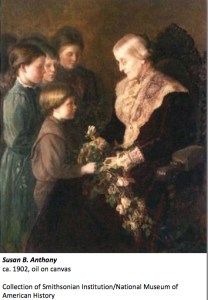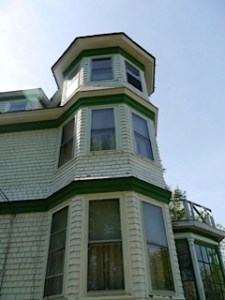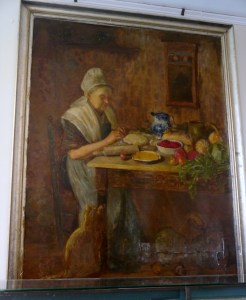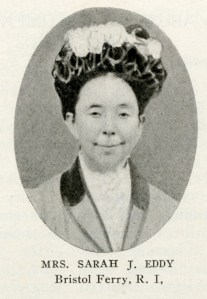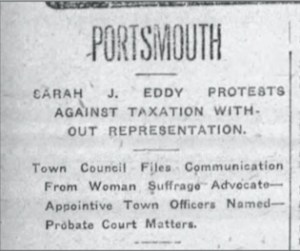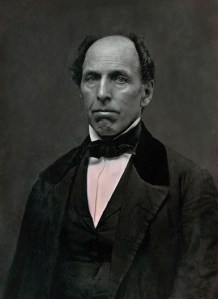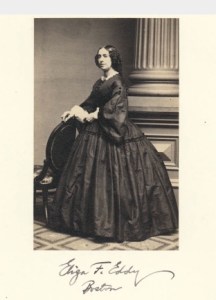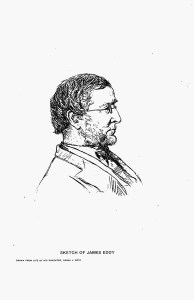Sarah Eddy’s mother and grandmother left Susan B. Anthony money in their wills to further the cause of woman’s suffrage, but the two ladies had not met until 1885. Miss Anthony had been able to get away from her work to go to the “Progressive Friends” (a Quaker offshoot) meeting in Pennsylvania. In her diary she wrote: “Last evening as I sat on the sofa Miss Eddy put her arms around me and said, ‘I am so glad I love you; I should have felt very sorry if I had not.’ And so should I, for the sake of her dear mother and grandfather, who had so much confidence in me.”
Sarah and Susan went on to New York together and then to visit Elizabeth Cady Stanton. A friendship was formed that lasted until Susan’s death. Miss Anthony could not be there when Sarah would visit Rochester for a convention. Miss Anthony wrote a friend “I am sure you would be glad to entertain her, she is a sweet, lovely little woman; thoroughly sympathizing with everything and everybody that suffers injustice. I am very sorry that sister Mary and I must be away and can not have the dear girl with us.” *
Susan B. Anthony came to Portsmouth to visit Sarah and sit for a portrait. In August of 1901 a Rochester newspaper account quotes Miss Anthony saying that after a meeting in Buffalo – “Oh, after that I am going to make a long promised visit at Bristol Ferry, with Mrs. Sarah Eddy,…Mrs. Eddy has been trying to get me to sit for her for my portrait for years, but I have never seen the time when I could stay long enough, but now that I am taking life so easy that I have consented, and she will see what she can do with me as her subject…**
Miss Anthony would write to her sister about the visit. Every morning was spent sitting for the two portraits Sarah was painting. One was a “bust portrait” – the other was a larger image of Susan’s 80th birthday celebration. This birthday celebration was two years before in Washington, D.C. Eighty children filed pass Miss Anthony to bring her an American Beauty rose. Sarah used local children as her models. As a subject, Susan B. Anthony didn’t consider the portrait flattering. In a letter almost a year later to Sarah, she would write that “There is something about the hollowness of the left cheek that makes me look as if I had had a ball thrown at me and hit me good and hard! Could you fill it out with a touch of the brush?” ***
In her letter to her sister Susan wrote: “Every afternoon I have the most refreshing sleep and when I wake the slanting rays of the sun are shining on Narragansett Bay and from all the five windows of my big room is the most glorious view imaginable. We have delightful drives over the old stone bridge that connects us with the mainland, to Tiverton and along the shores of Sconset River, which is really an arm of the ocean, and here we can see the whole length of the island with Newport in its beauty on the coast. It is ten miles away and we went by train one day, took the famous ocean drive and passed the palaces of the nabobs. I went in the carriage one afternoon to call on Julia Ward Howe, whose summer home is six miles from here; she was charming and I had an interesting time.” ****
A Rochester newspaper account of the visit reports that Miss Anthony visited the women’s section of Brown University. She remarked to the women: I see you girls at present have to peek over the fence at the boys, but the time will come when you will be admitted there on equal terms with them.” The 200 women students applauded the idea. *****
- *From “Selected Papers of Elizabeth Cady Stanton and Susan B. Anthony, 1880-1887. Rutgers, 1997.
- **Rochester Democrat and Chronicle (Rochester NY, 8/11/1901)
- ***Letter from Susan B. Anthony to Sarah Eddy – June 12, 1903 in the collection of the University of Rochester.
- ****The Life and Work of Susan B. Anthony, Vol. 3, Ida Husted Harper 1908.
- *****Rochester Democrat and Chronicle (11/8/1901).
